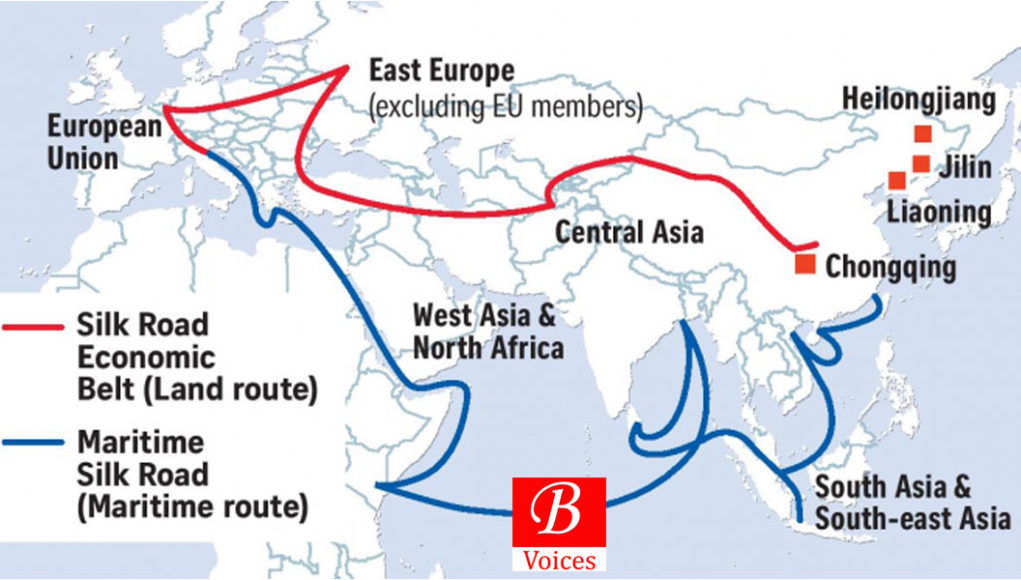Babar Zehri
The key Chinese foreign policy-makers including the whole standing committee of politburo summoned a landmark conference that was known as ‘Peripheral Diplomacy’. It was basically aimed at outlining the country’s strategic direction, in particular, in its near abroad. In the conference, President Xi categorically articulated the nodal points of the peripheral diplomacy, arguing that: “The core concern of the peripheral diplomacy constitutes forging stability in China’s vicinity. China needs to invest its energy in fostering regional economic integration by orchestrating connectivity & infrastructure buildup. It is exigent for China to construct a regional economic order by developing a 21st century Maritime Silk Road and Silk Road Economic Belt”. The conference is regarded as a climacteric in the evolution of China’s foreign policy. It represents a great leap outward on the part of China that is bent upon creating an economic, political and strategic fortification around its surroundings, and asserting itself on a global scale. China’s political and geostrategic assertion in the world is undergirded upon its rise as a geo-economic superpower in the world only seconding the declining US global economic and political clout.
Moreover, the belt and road enterprise is generally contended to have been motivated by broad geostrategic goals. The China-Pakistan-Economic-Corridor (CPEC) characterizes a classic example corroborating the aforementioned contention. It stands as a ‘flagship’ component of the belt and road project. The proximity of Gwadar Port to the Persian Gulf cuts short the distance traversed by the Chinese ships for energy supplies, travelling all the way from the Strait of Malacca in Southeast Asia. The port is expected to become a transshipment-point catering to China’s energy needs.
Inter alia, the Gwadar is a deep-sea port as well facilitating the accommodation of submarines and aircraft carriers. Against this backdrop, the port is also anticipated to serve as a crucial naval hub for the Peoples Liberation Army’s Navy for its navigational activities, reinforcing China’s ‘Blue Water Strategy’. On the whole, China is vigorously seizing upon its mammoth economic-might and huge foreign reserves to consolidate its position in the region, in particular, and in the world as a whole.
Apart from the foregoing debate, the belt and road drive is also generally touted to be a strategic counterpoise on the part of Xi regime to Obama administration’s ‘Pivot to Asia’ gamble. It seems logical that Xi initiated the enterprise as a counterbalancing move to the US policies of ‘Asian Pivot’ and ‘Trans-Pacific Partnership (TPP)’ in the broader Indo-Pacific and Asia-Pacific Rim regions. However, on the flipside, the coming into power of Trump as a result of 2016 U.S elections and the subsequent nullification by Trump administration of TPP in 2017 added luster to the belt and road venture. By corollary, such a move on the part of Washington has conceivably damaged her credibility among her allies in the region. Also, the move went a long way in promoting the image of Beijing as the new ‘Champion’ of free trade in the world. Beijing has engaged itself in nesting regional trade pacts and partnerships including One-Belt-One-Road and Regional Comprehensive Economic Partnership. Evidences point to the fact that some regional allies of US are increasingly moving into the Chinese ambit of influence for economic leadership. President Rodrigo Duterte, for instance, has- despite outstanding disputes over South China Sea Islands- wholeheartedly embraced an entente cordiale with Beijing.
Realistically speaking, the perusal of the broad literature on the geopolitics of belt and road reveals the fact that its geostrategic dimensions are exaggerated at the expense of its broader geo-economic objectives. Nonetheless, the two imperatives are not contradictory, rather, complementary in their very nature. In fact, China is trying to assert itself in the region by hatching a vast network of economic integration through its belt and road project. The underlying aim of China lies in establishing a ‘Regional Production Chain’ that would enable it to become the locus of innovation and sophisticated manufacturing and standard setter.
In addition, the central thrust of China’s belt and road project encompasses three-fold motives: through tight economic integration with the regional economies, fostering regional progress in China; by exporting Chinese standards, upgrading Chinese industry; and, coping with the issue of excess capacity. To this end, by closely knitting together the regional economies with Beijing in a cobweb structure of complex interdependence through belt and road initiative, deriving much of the motivation from such theorists as Joseph Nye and Robert Keohen, China is best suited to achieve humungous geopolitical goals.
Nevertheless, insufficient political understanding between/among some OBOR participant states combined with security issues and political instability facing others, constitute one of the formidable challenges to the much-cherished China-led belt and road venture. Furthermore, the initiative, with politico-economic orientations, contains the seeds of, global cooperation and coordination as well as large-scale global conflagration with unprecedented geopolitical ramifications. The geopolitics of ports and pipelines of Beijing’s nascent undertaking accounts for a substantial threat to Washington’s global hegemony. In a nutshell, whatever its limitations and/or qualifications, Beijing’s inceptive Silk Road project, holds a considerable potential to transform the global geopolitical landscape.
The writer holds a degree in BS Political Science from Quaid-e-Azam University, Islamabad.
Disclaimer: Views expressed in this article are those of the author and Balochistan Voices not necessarily agrees with them.
Share your comments!








